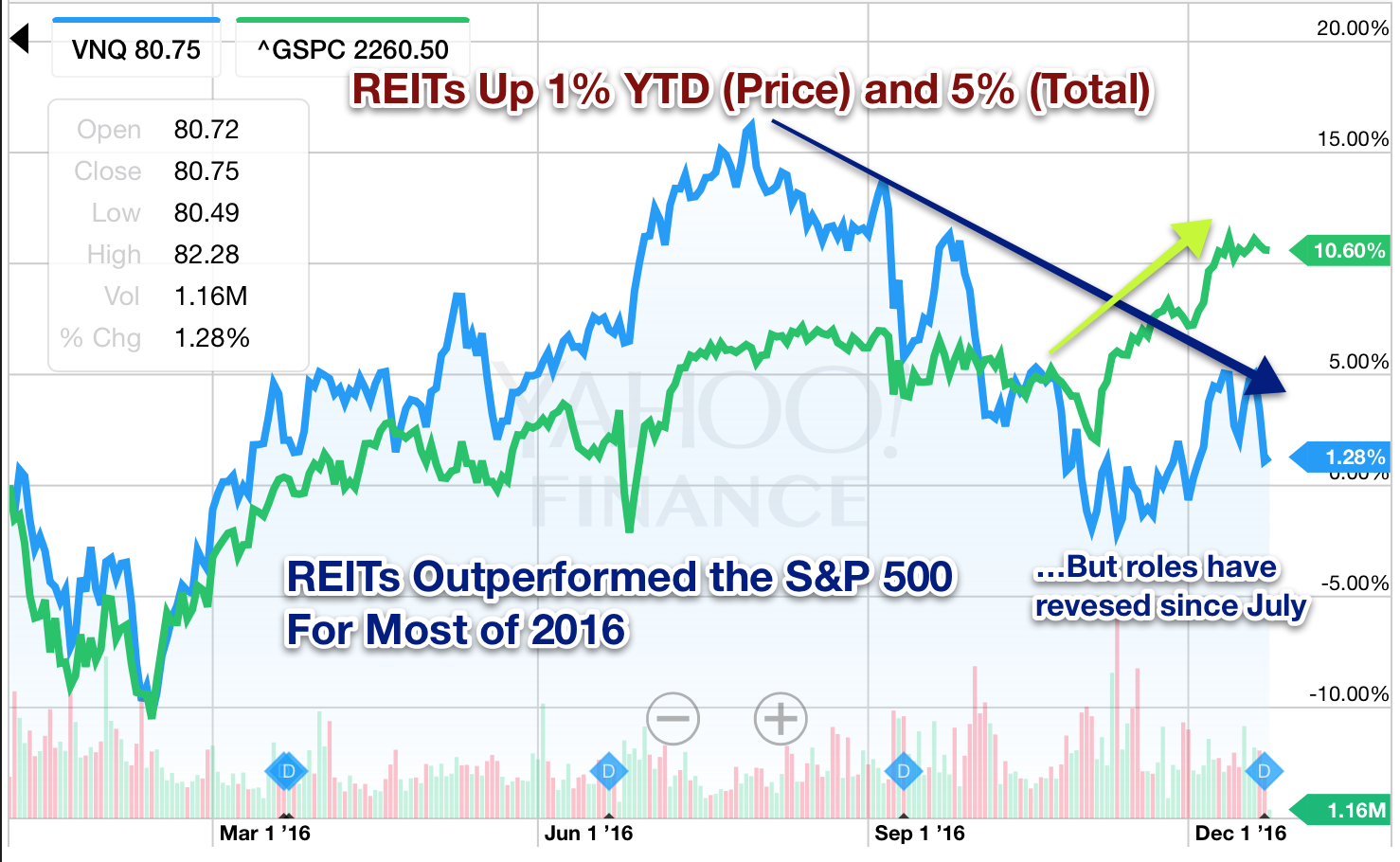Trump Throws Monkey Wrench Into REIT Sector The columnist doesn't seem to know how to read a stock-chart. The REIT ETF, VNQ peaked in price on 8/1/16. At that point, its price move YTD was 14% -- an outsized gain for a full year, let alone 2/3 of a year.
At that point, its price receded until the week of the election. --- during that time, right up until election day, the likelihood of a Trump victory seemed to recede every week. -- So if politics was effecting the price of REITS, the decline was discounting an HRC victory, not a Trump victory. Its price is up modestly since then. --- which is a standard seasonal bullish period (Nov-Dec), for stocks generally, and also for REITs specifically.
So really, "nothing to see here". But of course, journalists don't get paid to write that.
Trump Throws Monkey Wrench Into REIT Sector "Donald Trump's election in November further contributed to those trends. The election and his attraction to a stronger dollar have helped spur higher rates ...". This quote has it backwards.
It's the other way around. Higher rates since the election caused the Dollar to soar against other curriencies. (The author suggests the opposite). And I'm not sure there was any intent on the part of Trump either. Investors, fearing higher inflation if he funds massive infrastructure with debt have reacted predictably by demanding a higher rate of return on money lent. That's why rates have risen since his election. Currency traders, seeing the now higher rates available on U.S. debt have consequently bid the dollar higher against other currencies. Remember, however, the dollar was already sitting at multi-year highs before the election. Even at 1.37% on the 10-year the dollar looked attractive against many other currencies where negative rates had been imposed by central banks desperate to spur growth and inflation. (The Federal Reserve also contributed to higher rates, but the trend was well in place before they acted.)
As suggested by others, a strong dollar cuts both ways. It makes imported goods cheaper for Americans to buy but harms U.S. exporters by making their products more expensive (and less competitive) abroad. Perhaps missing from the article/discussion is that a strong currency can have deflationary consequences. That's one reason nations around the world have been attempting to weaken their currencies. As for REITS, don't feel too sorry for them. I purchased a small hold in OREAX in early September, 2015. In fewer than 16 months it's up 17.5% - not too shoddy.
2016 Capital Gains Estimates So, Mairs & Power might well be the very LAST to pay-out profit to shareholders:
MPGFX $5.04/share
MAPOX $1.58
MSCFX $0.46 cents
Josh Brown: Chart O’ The Day: Is This It?
The Breakfast Briefing: Dow On Track To Make A Fresh Attempt To Hurdle Over 20,000 erudite
It fascinates me that people obsess about round numbers on indices.
It is fascinating isn't it? Not just stock indexes. Toss in 50th anniversaries, turning 70 or
100, or becoming a
millionaire - to name a few. The goverrnment, however, seems not to have such fixation. Witness the 70.5 years of age RMD requirement or tax brackets like 28 and 33%.
Is Dow 20,000 meaningful? Hardly. But if it's like Dow
10,000 the gang at CNBC will celebrate. Unlike your 50th anniversary, they'll probably get to celebrate Dow 20,000 more than once.
There could be a psychological aspect to all this that will motivate those investors who are less erudite than we to throw caution to the wind and start pouring money into an already hot market, driving indexes even higher for some period of time. Or, I suppose, the opposite may also accur - with the daunting figure stoking fear in the hearts of many and causing stocks to sell off.
Mark Hulbert: What This Week’s Stock Market Will Tell You About 2017 Totally agree with prior posts. "This" week tells us NOTHING, except what happened THIS WEEK. Haven't we all learned that from the last 12 months?
